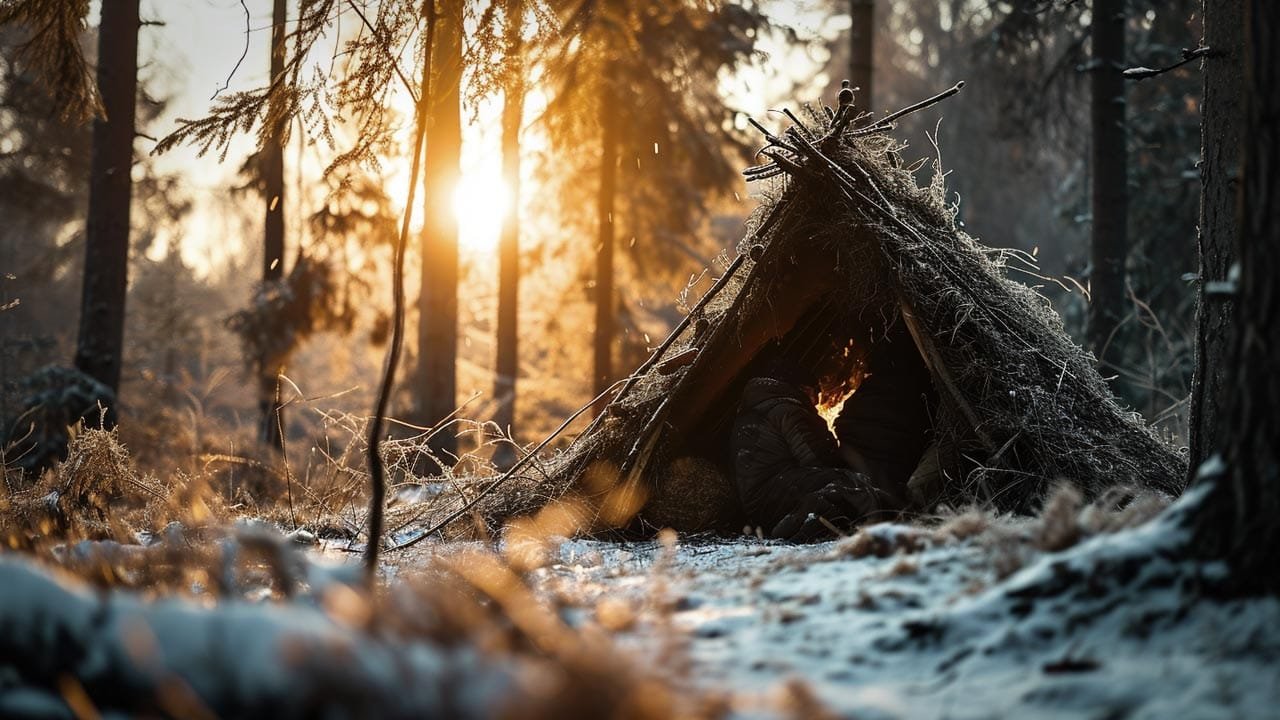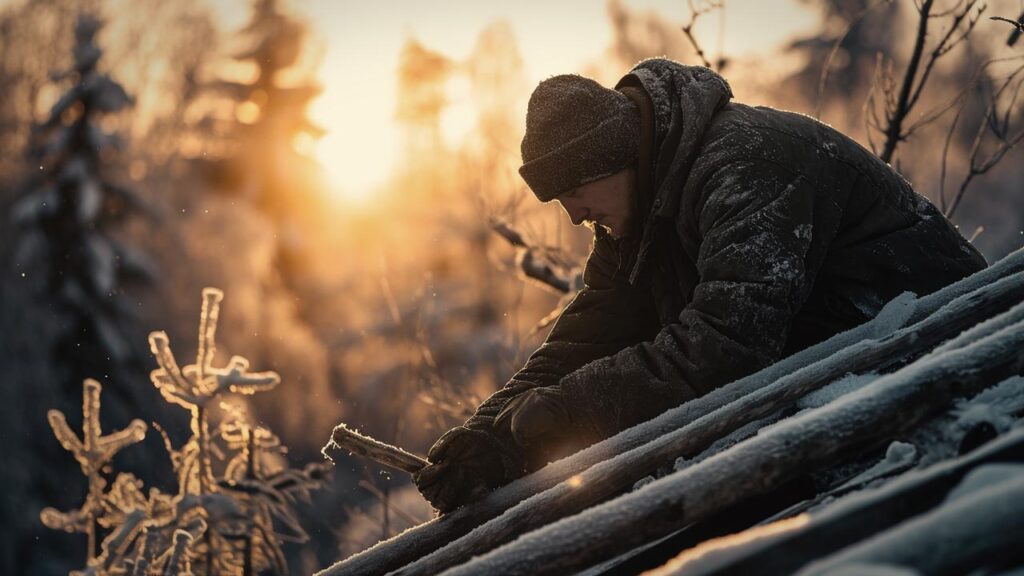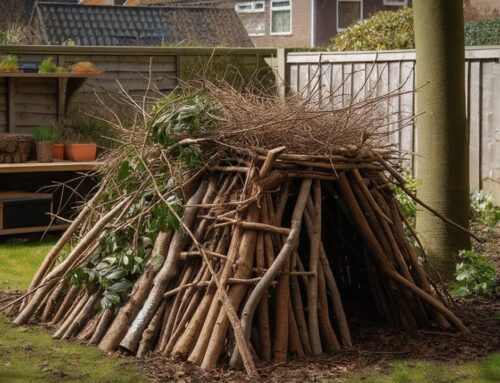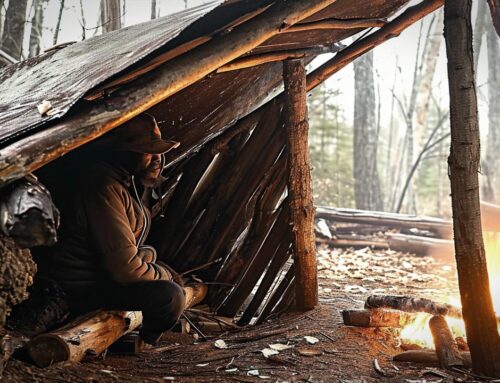Warming a Survival Shelter, Insulating Techniques using Natural Materials
Building a Warm Shelter is a critical survival technique. I don’t care for the cold, especially when I’m trying to sleep. I’ve learned stacking on clothing goes a long way. I take my pant leg ends and pull my socks over the ends. Another trick I use is taking a deep breath, and slowly exhale under my shirt, yes, there’s quite a bit of hot air. Once I’m fairly warm, I’ll seal the covers around me. Enough about that, let’s build a shelter!
Key Takeaways
- Understanding the basics of shelter construction and insulation using natural materials.
- Tips for choosing the best location and managing time efficiently during construction.
- Essential components and techniques for a sturdy, insulated survival shelter.
Table of Contents
- Basics of Survival Shelter Structures
- Types of Survival Shelters
- Top 10 Frequently Asked Questions
- Conclusion

Basics of Warm Survival Shelter Structures
Choosing the Right Location for Your Shelter
Location is crucial when building a survival shelter. The first step is to find a safe and strategic spot. Avoid low areas prone to water accumulation and keep a safe distance from potentially hazardous dead trees. Additionally, consider proximity to essential resources like water and food. This planning ensures your shelter is not only safe but also practical, reducing the need for extensive travel to gather daily necessities.
Time Management in Shelter Construction
Time is of the essence when building a survival shelter, especially as daylight fades. Aim to start construction at least two hours before sunset, accounting for earlier darkness in dense forests. This window provides enough time to build a basic structure without rushing, which is crucial for ensuring the shelter’s effectiveness and your safety.
Essential Components of a Survival Shelter
The foundation of any survival shelter is its structure. A strong ridgepole, typically double your height, forms the backbone of the shelter. Supported by a sturdy rest, like a boulder or tree fork, it should form a right-angle triangle with the ground. Ribbing along the sides of the ridgepole adds stability and support for insulating materials. The size of the shelter should be just enough to fit you comfortably, ensuring heat retention and efficient use of materials.
Building the Shelter Framework
Once the location and structure are set, it’s time to focus on the framework of your survival shelter. The ridgepole and ribs should be securely placed, ensuring the structure’s stability. This framework is the skeleton of your shelter, crucial for supporting the subsequent layers of insulation and protection. Remember, the framework’s strength directly impacts the shelter’s ability to withstand elements like wind and rain.
Selecting Insulating Materials
The choice of insulating materials is vital for a warm survival shelter. Dry materials such as dead pine needles, grass, and broad leaves are ideal for trapping heat. If dry materials are scarce, green plant material like hay, straw, or conifer boughs can be used. These materials not only provide insulation but also add to the shelter’s overall stability and comfort.
Constructing Warm Survival Shelter Roof and Walls
With the framework in place, begin constructing the roof and walls. Start with a lattice of twigs and brush atop the ribbing, which acts as a net to hold the insulating materials. Layer these materials until they are about two feet deep, ensuring ample insulation. If you have a tarp or garbage bags, place them on top for additional waterproofing. Remember, the thicker the insulation, the warmer the shelter will be, especially during colder nights.
Additional Tips to Warm Survival Shelter with Enhanced Insulation
To further enhance the insulation of your shelter, consider camouflaging it with natural elements like branches and bushes. This not only integrates the shelter with its surroundings for security but also adds an extra layer of insulation. If you’re carrying a weapon, create a concealed storage space within the shelter for safety. Finally, consider building a small ditch in front of the shelter for additional protection and quick access in case of an emergency.
Types of Survival Shelters
Building a Teepee Shelter
A teepee shelter, inspired by traditional Native American dwellings, is effective for survival situations. Begin by gathering long branches or poles and tying them together at the top to form a cone-like structure. Cover this frame with available foliage, ensuring gaps are filled for insulation. Inside, a layer of dry leaves or pine needles can provide additional warmth. Remember, the teepee’s design allows for a central fire, enhancing warmth within the shelter.
Using a Poncho for Shelter
A poncho can be a versatile tool in survival situations. If you have a poncho, it can be used as an effective shelter. String it up between two trees and weigh down the sides with rocks or sticks. For added insulation, stuff the sides with leaves or grass. In colder climates, the poncho can act as an additional layer over a more structured shelter, offering extra waterproofing and wind resistance.
Building a Lean-to Shelter
The lean-to is one of the simplest and most effective survival shelters. Find two trees close to each other and secure a ridgepole horizontally between them. Lean branches at an angle against this pole, then cover with leaves, grass, or boughs for insulation. Ensure the open side of the lean-to is opposite the wind’s direction to maximize warmth and protection from the elements.
Constructing a Platform Shelter
In damp or flood-prone areas, a platform shelter can keep you dry and safe. Use sturdy branches or logs to create a raised platform above the ground. Cover this platform with smaller branches and leaves for insulation. This type of shelter is particularly effective in wet environments, as it elevates you above ground moisture and potential flooding.
Incorporating Fire for Warmth
Incorporating a fire inside your shelter can significantly increase warmth. However, it’s essential to do this safely to avoid hazards. If your shelter design allows, create a small fire pit inside or immediately adjacent to the shelter, ensuring there’s an opening for smoke to escape. Be cautious with the size of the fire and never leave it unattended. A fire not only provides warmth but can also be used for cooking and signaling for help if needed.

Top 10 Frequently Asked Questions
Conclusion
Building a warm survival shelter using natural materials is an invaluable skill for anyone venturing into the wild. By understanding the basic principles of shelter construction, selecting the right materials for insulation, and incorporating techniques like fire for warmth, you can create a safe, warm, and comfortable space in the wilderness. Remember my stacking your clothing hack, the key to effective survival shelter building is preparation, knowledge, and a respect for nature’s resources.








Leave A Comment